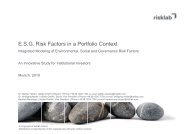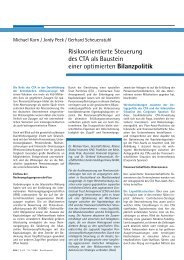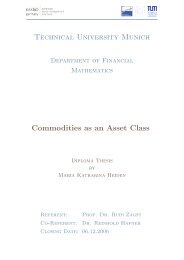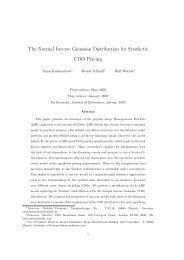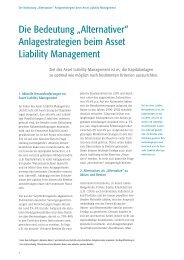Technische Universität München Credit as an Asset Class - risklab
Technische Universität München Credit as an Asset Class - risklab
Technische Universität München Credit as an Asset Class - risklab
You also want an ePaper? Increase the reach of your titles
YUMPU automatically turns print PDFs into web optimized ePapers that Google loves.
CHAPTER 2. CREDIT RISK TRANSFER<br />
Figure 2.7: B<strong>as</strong>ic structure of a securitisation<br />
the <strong>as</strong>set pool or its risk, funded by the issu<strong>an</strong>ce of ABS. The originator c<strong>an</strong> often serve<br />
<strong>as</strong> servicer, who is responsible for the m<strong>an</strong>agement of the <strong>as</strong>set pool, partly including the<br />
regular collection of instalments from the borrowers, <strong>an</strong>d for regular reportings for investors<br />
<strong>an</strong>d rating agencies in return for a servicing fee. The trustee represents the investors’<br />
interests. He supervises the regularity of the SPV <strong>an</strong>d the <strong>as</strong>set pool m<strong>an</strong>agement. In<br />
addition, he also supervises the accomplishment of regular reports <strong>an</strong>d verifies losses.<br />
Sometimes, he is responsible for the payments to the investors such <strong>as</strong> shown in Figure<br />
2.7. These t<strong>as</strong>ks are often performed by <strong>an</strong> independent chartered account<strong>an</strong>t.<br />
In general, ABS are issued in different risk cl<strong>as</strong>ses, so-called tr<strong>an</strong>ches. In order to be<br />
able to place the securities in the capital market, it is necessary to get the tr<strong>an</strong>ches rated<br />
by a large rating agency. The agency regularly monitors the risk involved in the single<br />
tr<strong>an</strong>ches <strong>an</strong>d adjusts the rating if necessary.<br />
Ratings c<strong>an</strong> be influenced <strong>an</strong>d improved by so-called credit enh<strong>an</strong>cements. <strong>Credit</strong><br />
enh<strong>an</strong>cements are a distinctive feature of securitisations, unlike conventional corporate<br />
bonds, which are often unsecured. Through a credit enh<strong>an</strong>cement, a security’s or tr<strong>an</strong>che’s<br />
credit quality is raised above that of the underlying <strong>as</strong>set pool. We c<strong>an</strong> distinguish between<br />
a variety of internal <strong>an</strong>d external enh<strong>an</strong>cements that are used to limit specific risks 70<br />
accruing from a securitisation <strong>an</strong>d to decre<strong>as</strong>e the probability of default in the tr<strong>an</strong>ches.<br />
The internal enh<strong>an</strong>cements arise from the <strong>as</strong>set pool or the involved parties, examples<br />
are subordination, overcollateralisation, excess spread <strong>an</strong>d c<strong>as</strong>h reserves. External credit<br />
enh<strong>an</strong>cements are provided by a third party. Examples are fin<strong>an</strong>cial guar<strong>an</strong>tees, letters of<br />
credit, credit insur<strong>an</strong>ces <strong>an</strong>d c<strong>as</strong>h collateral accounts. 71<br />
70 These are explained in Section 2.4.4.<br />
71 For a detailed description of these credit enh<strong>an</strong>cements, we refer for example to [Oes04], pp. 22-23,<br />
25



